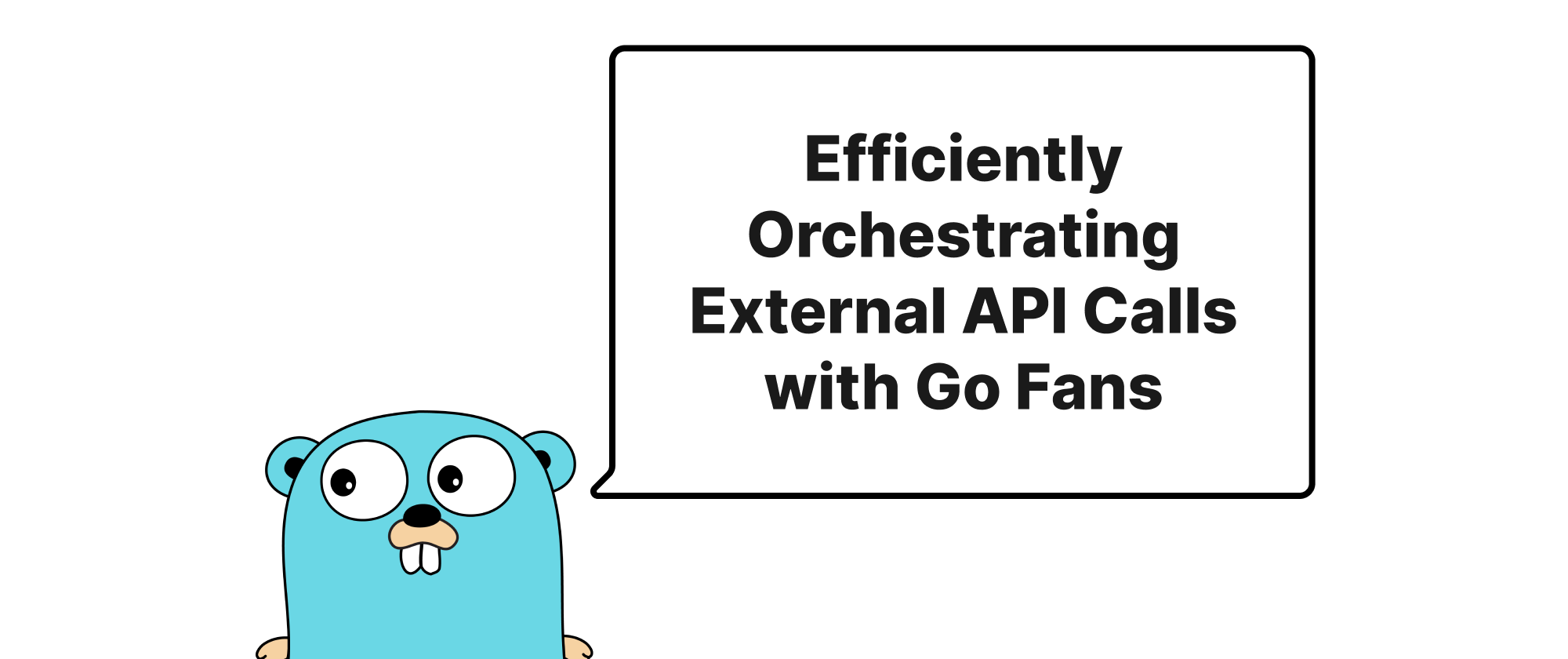Efficiently Orchestrating External API Calls with Go Fans
Olivia Novak
Dev Intern · Leapcell

Introduction: Navigating the Multi-API Data Chasm
In today's interconnected software landscape, applications rarely live in isolation. More often than not, they rely on a myriad of external APIs to fetch diverse data crucial for their functionality. Imagine building a dashboard that pulls user profiles from an authentication service, order history from an e-commerce platform, and real-time stock prices from a financial data provider. Each API call, while necessary, introduces latency. Making these calls sequentially can drastically slow down your application, leading to a sluggish user experience and inefficient resource utilization. This is where the power of concurrency becomes paramount. Go, with its built-in goroutines and channels, offers elegant solutions for tackling such challenges. This article will delve into the "Fan-In, Fan-Out" pattern, demonstrating how it can be leveraged to concurrently process data from multiple external APIs, thereby significantly improving performance and responsiveness.
Our journey will explore the core concepts behind this powerful pattern, provide practical Go code examples, and highlight its real-world applicability in building robust and scalable systems.
Decoding the Fan-In, Fan-Out Pattern
Before diving into the implementation details, let's establish a common understanding of the key concepts involved in the Fan-In, Fan-Out pattern.
- Goroutines: Lightweight, independent units of execution in Go. They allow functions to run concurrently, performing multiple tasks simultaneously without the overhead of traditional threads.
- Channels: Typed conduits through which goroutines can send and receive values. They provide a safe and synchronized way for goroutines to communicate, preventing race conditions and simplifying concurrent programming.
- Fan-Out: This refers to the technique of distributing a single task or input to multiple worker goroutines. In our context, it means launching multiple goroutines, each responsible for making an independent API call.
- Fan-In: This is the reverse of fan-out. It involves aggregating results from multiple worker goroutines into a single channel. Here, it means collecting the responses from all our API-calling goroutines into a unified stream for further processing.
The Problem with Sequential API Calls
Consider a scenario where you need to call three external APIs. If each call takes 1 second, a sequential approach would take a total of 3 seconds.
package main import ( "fmt" "time" ) func fetchDataFromAPI1() string { time.Sleep(1 * time.Second) // Simulate API call latency return "Data from API 1" } func fetchDataFromAPI2() string { time.Sleep(1 * time.Second) // Simulate API call latency return "Data from API 2" } func fetchDataFromAPI3() string { time.Sleep(1 * time.Second) // Simulate API call latency return "Data from API 3" } func sequentialAPICalls() { start := time.Now() res1 := fetchDataFromAPI1() res2 := fetchDataFromAPI2() res3 := fetchDataFromAPI3() fmt.Println(res1) fmt.Println(res2) fmt.Println(res3) fmt.Printf("Sequential calls took: %v\n", time.Since(start)) } func main() { fmt.Println("Running sequential API calls:") sequentialAPICalls() }
This output would show a total execution time of roughly 3 seconds. This is clearly inefficient when API calls are independent.
Implementing Fan-Out: Concurrent API Requests
The "Fan-Out" stage involves launching multiple goroutines, each responsible for making an external API call. Each goroutine will send its result to a dedicated output channel.
package main import ( "fmt" "sync" "time" ) // Simulate an external API call func callAPI(apiName string, delay time.Duration) <-chan string { out := make(chan string) go func() { defer close(out) // Ensure channel is closed when goroutine finishes fmt.Printf("Calling %s...\n", apiName) time.Sleep(delay) // Simulate network latency out <- fmt.Sprintf("Data from %s (took %v)", apiName, delay) }() return out } func main() { fmt.Println("Starting Fan-Out stage...") // Fan-Out: Launch multiple goroutines to call different APIs // Each API call function returns a channel to receive its result api1Channel := callAPI("API Service A", 2*time.Second) api2Channel := callAPI("API Service B", 1*time.Second) api3Channel := callAPI("API Service C", 3*time.Second) fmt.Println("\nAPI calls fanned out. Now waiting for results (Fan-In)...") // The Fan-In part will be implemented next. // For now, let's just drain the individual channels to see the concurrent effect. // This isn't true Fan-In yet, but demonstrates independent execution. fmt.Println(<-api1Channel) fmt.Println(<-api2Channel) fmt.Println(<-api3Channel) fmt.Println("\nAll API results received individually.") }
When you run this main function, you'll observe that "Calling API Service A...", "Calling API Service B...", and "Calling API Service C..." appear almost simultaneously. The program then waits for results, and they arrive as each simulated API call completes, showcasing concurrency.
Implementing Fan-In: Aggregating Results
The "Fan-In" stage is where we consolidate the results from all the individual API calls into a single channel. This allows a single consumer to process all the results as they become available.
package main import ( "fmt" "sync" "time" ) // Simulate an external API call func callAPI(apiName string, delay time.Duration) <-chan string { out := make(chan string) go func() { defer close(out) fmt.Printf("Calling %s...\n", apiName) time.Sleep(delay) out <- fmt.Sprintf("Data from %s (took %v)", apiName, delay) }() return out } // fanIn takes multiple input channels and multiplexes them into a single output channel. func fanIn(inputChans ...<-chan string) <-chan string { var wg sync.WaitGroup multiplexedChan := make(chan string) // Function to read from an input channel and send to the multiplexed channel multiplex := func(c <-chan string) { defer wg.Done() for val := range c { multiplexedChan <- val } } // Add a goroutine for each input channel to the WaitGroup wg.Add(len(inputChans)) for _, c := range inputChans { go multiplex(c) } // Launch a goroutine to close the multiplexed channel once all input channels are closed go func() { wg.Wait() // Wait for all multiplex goroutines to finish close(multiplexedChan) }() return multiplexedChan } func main() { start := time.Now() fmt.Println("Starting concurrent API calls with Fan-Out and Fan-In...") // Fan-Out: Launch goroutines for each API call api1Chan := callAPI("API Service A", 2*time.Second) api2Chan := callAPI("API Service B", 1*time.Second) api3Chan := callAPI("API Service C", 3*time.Second) // Fan-In: Aggregate results from all API channels into a single channel unifiedResults := fanIn(api1Chan, api2Chan, api3Chan) // Process the results as they come in from the unified channel for result := range unifiedResults { fmt.Printf("Received: %s\n", result) } fmt.Printf("All concurrent calls completed in: %v\n", time.Since(start)) }
When you run this enhanced example, you'll see a significant performance improvement compared to the sequential approach. The total execution time will be dominated by the slowest API call (API Service C, taking 3 seconds), rather than the sum of all calls. The output will show messages arriving as soon as an API call completes, demonstrating the concurrent processing.
The fanIn function is the core of the Fan-In stage. It takes a variable number of input channels (the results from our API calls) and creates a single multiplexedChan. For each input channel, it spawns a multiplex goroutine that continuously reads from the input channel and sends the received values to the multiplexedChan. A sync.WaitGroup ensures that the multiplexedChan is only closed once all input channels have been fully drained and their respective multiplex goroutines have finished.
Practical Applications and Benefits
The Fan-In, Fan-Out pattern is incredibly versatile and applicable in various scenarios:
- Data Aggregation: Combining data from multiple microservices or external data sources to build a composite view.
- Parallel Processing: Distributing a large computational task into smaller, independent sub-tasks that can be executed concurrently. For example, processing segments of a large file or performing distinct analyses on different datasets.
- Workflow Orchestration: Coordinating asynchronous operations where the results of several tasks need to be collected before proceeding to the next step.
- Real-time Dashboards: Continuously fetching and updating data from various real-time feeds (e.g., stock markets, sensor data) and presenting them on a single interface.
- Search Engines: Querying multiple indexes or data sources in parallel to quickly gather comprehensive results.
The primary benefits of using this pattern are:
- Improved Performance: By executing independent tasks concurrently, the overall execution time is drastically reduced.
- Increased Scalability: The pattern easily accommodates more API calls or processing tasks by simply launching more goroutines.
- Decoupling: Each API call or processing unit is independent, making the system more modular and easier to maintain.
- Resilience: Failures in one API call can be isolated, and strategies like retries or fallback mechanisms can be implemented per API without blocking others.
Conclusion: Harnessing Go's Concurrency for Scalable Data Processing
The Fan-In, Fan-Out pattern, empowered by Go's goroutines and channels, provides an elegant and highly effective approach to concurrently processing data from multiple external APIs. By strategically fanning out independent tasks and fanning in their results, developers can dramatically improve application performance, enhance scalability, and build more robust and responsive systems. This pattern epitomizes Go's philosophy of simple, powerful concurrency, enabling developers to easily orchestrate complex data flows. Embrace this pattern to unlock the full potential of your Go applications in an API-driven world.


